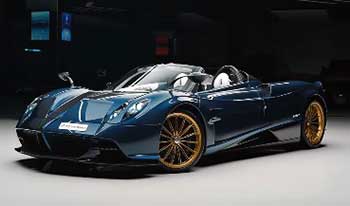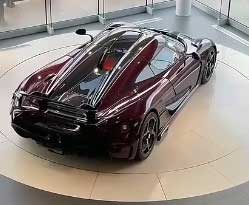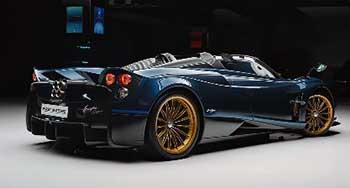
As a car enthusiast, I’ve always been captivated by the raw power and artistry of hypercars, and few brands ignite my passion like Pagani and Koenigsegg.
In this article, I’ll take you through my firsthand perspective on these automotive masterpieces, comparing their performance, design, and driving experience.
With a detailed look at their pros and cons, a comparison table, and practical insights, I aim to help you understand what makes each brand unique.
Whether you’re dreaming of owning one or just love the thrill of hypercars, join me in exploring Pagani versus Koenigsegg.
Comparison Table
| Feature | Pagani Huayra | Koenigsegg Jesko |
|---|---|---|
| Engine | 6.0L Twin-Turbo V12 | 5.0L Twin-Turbo V8 |
| Horsepower | 791 hp (Huayra BC) | 1,600 hp (Jesko Absolut, E85) |
| Top Speed | ~238 mph | ~300 mph (estimated) |
| 0-60 mph | 2.8 seconds | 2.5 seconds |
| Weight | ~2,976 lbs (Huayra Roadster BC) | ~3,064 lbs (Jesko) |
| Transmission | 7-speed single-clutch automated | 9-speed Light Speed Transmission |
| Price (Base) | ~$3.5 million (Huayra R Evo) | ~$3.0 million (Jesko) |
| Production | Limited (e.g., 40 Huayra RBCs) | Limited (e.g., 125 Jeskos) |
| Design Focus | Artistry, craftsmanship | Engineering, performance |
My Experience With Pagani
When I first laid eyes on a Pagani Huayra, it felt like stumbling upon a Renaissance sculpture that could hit 238 mph. The Huayra’s curves, carbon-fiber weave, and intricate details scream artistry.
Driving one, even briefly at a track event, was like conducting a symphony—every rev of the 6.0-liter twin-turbo V12, crafted by Mercedes-AMG, sang with a ferocity that made my heart race.
The interior, with its hand-stitched leather and exposed carbon, felt like a bespoke suit tailored for speed. Horacio Pagani’s vision of blending art and performance shines through in every detail, from the gullwing doors to the titanium exhaust that hums like a jet.
The Huayra’s handling is precise, though it demands respect. On a tight corner, the car’s active aerodynamics adjust to keep it planted, but the single-clutch transmission can feel abrupt compared to modern dual-clutch systems.
I found the Huayra less about raw numbers and more about the experience—every drive feels like an event. It’s not just a car; it’s a statement of passion and individuality. Owners I’ve spoken to echo this, describing their Paganis as extensions of their personalities, often customized to reflect their tastes in art or culture.
However, the Huayra isn’t perfect for everyone. Its focus on aesthetics sometimes overshadows practicality, and the price tag—often exceeding $3 million—reflects its exclusivity. Maintenance is another hurdle; finding technicians skilled enough to service a Pagani is like finding a watchmaker for a Patek Philippe. Still, the emotional connection it fosters is unmatched, making every moment behind the wheel feel like a privilege.
My Experience With Koenigsegg

Koenigsegg’s Jesko, on the other hand, is a marvel of engineering that feels like it was designed by a mad scientist obsessed with speed.
I had the chance to ride shotgun in a Jesko during a demonstration, and the acceleration pinned me to the seat like a rollercoaster hitting its peak.
The 5.0-liter twin-turbo V8, producing up to 1,600 horsepower on E85 biofuel, is a beast that roars with a mechanical intensity.
Christian von Koenigsegg’s philosophy of pushing boundaries is evident in innovations like the Light Speed Transmission, which shifts gears faster than I can blink.
The Jesko’s design is sleek and aggressive, with a low-slung stance that screams performance. Inside, it’s less ornate than a Pagani but packed with tech, like the digital dashboard and haptic controls.
The car’s engineering focus makes it feel like a spaceship—every component, from the carbon-fiber chassis to the active rear wing, is optimized for speed and stability. On the track, it’s forgiving yet thrilling, with torque vectoring and adaptive suspension making high-speed corners feel effortless.
Yet, the Koenigsegg experience comes with challenges. The sheer power can be intimidating, especially for less experienced drivers, and the brand’s focus on performance over luxury means the interior, while functional, lacks the Pagani’s artistic flair. Still, the Jesko’s ability to redefine what’s possible in a hypercar left me in awe, and it’s clear why enthusiasts call it a “driver’s car.”
Also read: My Thoughts on Acura ILX Vs. Honda Accord
Pros Of Pagani
- Unparalleled Craftsmanship: The Huayra’s interior is a work of art, with hand-stitched leather and carbon-fiber details that make every touchpoint feel bespoke.
- Emotional Driving Experience: The V12’s sound and the car’s dramatic styling create a visceral connection that’s hard to match.
- Customization Options: Pagani’s atelier approach lets buyers personalize nearly every aspect, from paint to interior materials, making each car unique.
- Track-Proven Performance: Models like the Huayra Roadster BC set lap records, like 2:23.08 at Spa-Francorchamps, proving their racing pedigree.
- Exclusivity: With only 40 Huayra Roadster BCs built, owning one feels like joining an elite club.
- Active Aerodynamics: The Huayra’s flaps adjust in real-time to optimize downforce, enhancing stability at high speeds.
- Heritage and Story: Horacio Pagani’s journey from Argentina to Lamborghini to founding his brand adds a romantic narrative that resonates with enthusiasts.
Pagani’s strength lies in its ability to blend art and performance. The Huayra’s 791 horsepower feels alive, and the car’s lightweight carbotanium chassis—20% stiffer than standard carbon fiber—makes it agile yet stable.
I’ve heard owners compare driving a Pagani to wearing a tailored Italian suit: it fits perfectly and makes you feel like royalty. The attention to detail, like the titanium bolts and handcrafted exhaust, elevates it beyond mere transportation. It’s a car for those who value emotion over raw numbers, and its rarity ensures you’ll rarely see another on the road.
Cons Of Pagani
- High Maintenance Costs: Servicing a Pagani requires specialized technicians, and parts like the carbotanium body are astronomically expensive.
- Single-Clutch Transmission: The 7-speed automated manual can feel jerky compared to dual-clutch systems, especially in low-speed scenarios.
- Limited Practicality: With minimal cargo space and a stiff ride, the Huayra isn’t suited for daily driving or long trips.
- Intense Driving Dynamics: The Zonda’s twitchy rear end demands skilled handling, and even the Huayra requires focus at high speeds.
- Exclusivity Barrier: Limited production means long waitlists, and the $3.5 million price tag puts it out of reach for most.
- U.S. Legality Issues: Some models, like the Zonda, aren’t street-legal in the U.S. due to emissions and safety regulations.
- Resale Complexity: Selling a Pagani can be challenging due to its niche market and high maintenance demands.
The Pagani experience comes with trade-offs. The single-clutch transmission, while lighter, lacks the smoothness of modern alternatives, which I noticed during low-speed maneuvers. Maintenance is a headache—dealerships are rare, and repairs can take months.
The car’s focus on track performance means it’s not the most comfortable for casual drives, and its rarity can feel like a double-edged sword: you’re part of an exclusive club, but finding buyers or service centers is tough. Still, for those who can afford it, these cons are often outweighed by the car’s emotional impact.
Maintenance Tips For Pagani

- Regular Inspections: Schedule annual checks with a Pagani-certified technician to ensure the V12 engine and carbotanium chassis remain in top condition.
- Tire Care: Use manufacturer-recommended tires and check pressure monthly, as the Huayra’s performance relies heavily on grip.
- Fluid Maintenance: Replace engine oil and transmission fluid every 6,000 miles or annually to prevent wear on the V12 and single-clutch system.
- Protect the Finish: Apply a ceramic coating to the carbon-fiber body to protect against UV damage and minor scratches.
- Climate-Controlled Storage: Store the car in a temperature-controlled garage to preserve the leather interior and prevent carbon-fiber degradation.
- Track Prep: Before track days, inspect brakes and suspension components, as the Huayra’s aggressive dynamics can stress these parts.
- Battery Maintenance: Check the battery monthly, as the car’s electronics can drain it during long periods of inactivity.
Maintaining a Pagani is like caring for a piece of fine art. The V12 engine, sourced from Mercedes-AMG, requires meticulous attention to fluids and filters to keep its 791 horsepower humming. I’ve spoken to owners who emphasize the importance of tire care, as the Huayra’s low-profile tires wear quickly under aggressive driving.
The carbotanium chassis, while durable, needs protection from environmental damage, and a ceramic coating can save you from costly repaints. Regular inspections by Pagani’s limited network of technicians are non-negotiable, as even minor issues can escalate quickly. For track enthusiasts, prepping the car with a focus on brakes and suspension is crucial to avoid costly repairs.
Pros Of Koenigsegg
- Mind-Blowing Performance: The Jesko’s 1,600 horsepower and 300 mph potential make it one of the fastest production cars ever.
- Innovative Engineering: The Light Speed Transmission shifts in milliseconds, and the Triplex suspension ensures stability at extreme speeds.
- Fuel Flexibility: The Agera R and Jesko can run on E85 biofuel, offering eco-conscious performance without sacrificing power.
- Customization Freedom: Koenigsegg’s bespoke program lets buyers tailor everything, from paint to aerodynamics, rivaling Pagani’s personalization.
- Track Dominance: The Agera RS set a world record with a 277.9 mph average speed, showcasing Koenigsegg’s speed obsession.
- Advanced Technology: Features like torque vectoring and 3D-printed components push the boundaries of automotive engineering.
- Reliability Reputation: Owners report fewer issues compared to other hypercars, thanks to high-quality materials and simpler designs.
Koenigsegg’s engineering prowess is staggering. The Jesko’s 9-speed Light Speed Transmission is a game-changer, making shifts feel instantaneous. I was blown away by how the car’s active aerodynamics and suspension adapted to high-speed corners, keeping it glued to the track.
The ability to run on E85 adds a modern twist, appealing to those who want performance with a nod to sustainability. Owners often praise the brand’s reliability, a rarity in the hypercar world, and the customization options let you create a car that’s truly yours. It’s a machine built for those who crave speed and innovation above all else.
Read more: My Thoughts on Acura Integra Vs. Honda Accord
Cons Of Koenigsegg
- Intimidating Power: The Jesko’s 1,600 horsepower can overwhelm inexperienced drivers, requiring serious skill to handle safely.
- Less Luxurious Interior: Compared to Pagani, the Jesko’s cabin prioritizes function over opulence, which may disappoint luxury seekers.
- High Maintenance Costs: While more reliable than some, servicing the V8 and advanced tech requires specialized expertise.
- Limited Dealer Network: Koenigsegg’s small global presence makes finding service centers challenging, especially outside Europe.
- Aggressive Styling: The Jesko’s sinister look may not appeal to those who prefer Pagani’s elegant aesthetic.
- Pricey Options: Customization and high-end features can push the Jesko’s price well beyond its $3 million base.
- Track-Focused Ride: The stiff suspension and low ground clearance make it impractical for daily driving.
The Koenigsegg’s raw power is both its strength and its Achilles’ heel. I found the Jesko’s intensity thrilling but daunting—novice drivers could easily get in over their heads. The interior, while high-tech, lacks the Pagani’s artistic flair, feeling more like a cockpit than a lounge.
Maintenance, though less frequent than Pagani’s, still requires rare expertise, and the limited dealer network can mean long waits for service. The car’s aggressive styling and stiff ride prioritize track performance over comfort, which might not suit buyers looking for a more refined experience.
Maintenance Tips For Koenigsegg
- Annual Servicing: Book yearly checkups with Koenigsegg technicians to maintain the V8 engine and Light Speed Transmission.
- Tire Monitoring: Check tire wear and pressure regularly, as the Jesko’s high torque demands premium tires for optimal grip.
- Fluid Checks: Replace engine oil and coolant every 5,000 miles or annually to keep the twin-turbo V8 running smoothly.
- Aerodynamic Maintenance: Inspect active wings and flaps for wear, as they’re critical for high-speed stability.
- Battery Care: Monitor the battery for the hybrid system (in models like the Regera) to prevent power loss.
- Protect Carbon Fiber: Use a UV-resistant coating to shield the carbon-fiber body from sun damage.
- Track Preparation: Before track sessions, ensure brakes and suspension are inspected to handle the car’s extreme performance.
Koenigsegg’s maintenance is slightly less daunting than Pagani’s, but it’s still a commitment. The V8 engine, while robust, needs regular fluid changes to maintain its 1,600-horsepower output. I’ve heard from owners that tire wear is a constant concern, especially after track days, so investing in high-quality rubber is a must.
The active aerodynamics, like the Jesko’s massive rear wing, require periodic checks to ensure they function correctly. A UV coating protects the carbon-fiber body, and for hybrid models like the Regera, battery maintenance is critical. Regular servicing by Koenigsegg’s sparse network keeps the car at its peak.
Comparison With Other Brands
- Bugatti Chiron: Offers unmatched luxury and a top speed of 261 mph, but lacks the raw driving engagement of Pagani and Koenigsegg.
- Ferrari Pininfarina Battista: An electric hypercar with 1,900 hp, it’s faster to 60 mph (1.79 seconds) but misses the emotional engine note of Pagani’s V12 or Koenigsegg’s V8.
- McLaren P1: A hybrid with 903 hp, it’s more accessible at ~$1.5 million but lags in top speed and exclusivity compared to both brands.
- Lamborghini Sian: Its 819 hp hybrid V12 is powerful, but its $3.6 million price and less bespoke feel don’t match Pagani’s craftsmanship or Koenigsegg’s innovation.
- Rimac C_Two: With 1,914 hp, this electric hypercar rivals Koenigsegg’s acceleration but lacks the combustion engine’s soul.
- Aston Martin Valkyrie: Its 1,160 hp V12 and $3.2 million price compete closely, but its focus on track performance feels less versatile than Koenigsegg’s Jesko.
- Porsche 918 Spyder: A hybrid with 887 hp, it’s more practical for daily use but doesn’t match the exclusivity or top speed of Pagani or Koenigsegg.
Pagani and Koenigsegg stand out in the hypercar world for different reasons. Bugatti’s Chiron is a luxury titan, but its polished demeanor feels less engaging than the raw thrill of a Koenigsegg or the artistic drama of a Pagani. Electric hypercars like the Battista and Rimac C_Two offer blistering acceleration, but I miss the roar of a combustion engine.
McLaren and Lamborghini provide more accessible options, but they lack the bespoke exclusivity of Pagani’s atelier or Koenigsegg’s engineering wizardry. The Valkyrie comes close, but its track focus feels narrower than the Jesko’s versatility. Both Pagani and Koenigsegg cater to those who want more than just speed—they deliver experiences.
Frequently Asked Questions (FAQ)
It depends on your priorities. Koenigsegg excels in raw performance and engineering, while Pagani offers unmatched craftsmanship and emotional appeal. Test-drive both to see which resonates.
Some Pagani models, like the Zonda, don’t meet U.S. emissions and safety standards, requiring special exemptions for road use.
Pagani’s Huayra R Evo (~$3.5 million) is pricier than Koenigsegg’s Jesko (~$3 million), but customization can push either higher.
“Better” is subjective, but the Bugatti Chiron Super Sport (261 mph) and Rimac C_Two (1,914 hp) rival Koenigsegg’s performance in specific metrics.
Conclusion: For Pagani And Koenigsegg
You and I, as car enthusiasts, know that choosing between Pagani and Koenigsegg is like picking a favorite masterpiece. If you crave a car that’s art on wheels, with a soul-stirring V12 and bespoke craftsmanship, Pagani’s your dream.
If engineering marvels and blistering speed excite you, Koenigsegg’s innovations will blow your mind. Both brands push the limits of what’s possible, offering experiences that transcend mere transportation. Weigh your priorities—art versus engineering, emotion versus speed—and take the wheel of the hypercar that speaks to your heart.

